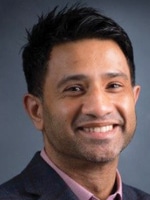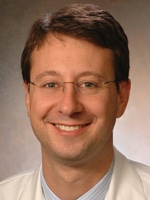May 2021—Next-generation sequencing analysis and interpretation, as well as reimbursement, were some of what CAP TODAY publisher Bob McGonnagle asked Illumina and Thermo Fisher executives and Jeremy Segal, MD, PhD, about when they gathered on a March 24 call.
McGonnagle asked, too, about variants of unknown significance and for views on what lies ahead for NGS. “Circulating tumor DNA analysis is starting to move wholesale into the academic setting,” along with other applications, says Dr. Segal, of the University of Chicago.
What they said about NGS now and in the future begins on this page. See also CAP TODAY’s guide to next-generation sequencing instruments.
In all other areas of laboratory instrumentation, we have multiple vendors. Yet in next-generation sequencing, as important as it is and with its rapid growth, we have two companies with offerings for labs to choose from. Can you comment on that?
Pierre Del Moral, PhD, MBA, senior segment marketing manager, oncology testing, Illumina: Only 15 percent of cancer patients are being currently tested with NGS nationally. That means there’s a lot of room to grow, which means that adoption is not wide across labs for various reasons. That probably is the reason that we, as NGS vendors, are looking at positioning our solutions in a way that they replace some entrenched technologies, and maybe it is the reason why some other technology vendors are not here yet—because of the acceptance of their technologies already implemented in the laboratory.
Sohaib Qureshi, PhD, director of product management, instrumentation, Clinical NGS Division, Thermo Fisher Scientific: I agree with Pierre. As the utility of NGS increases over time with therapeutic indications based off of NGS testing for specific biomarkers, you’ll see that shift start to happen. We’ll eventually get there as NGS starts going and gains entry into laboratories with less expertise.
Part of that is making the workflows much easier. There’s nothing push-button at the benchtop for NGS at the moment. Illumina, like Thermo Fisher, is trying to get there—to make everything faster, cheaper, and more automated. That’s the part that will help propel NGS and make it possible to penetrate that space where NGS testing will be required for the therapeutic indication.
The Association for Molecular Pathology released in March an interesting analysis of the effort required for molecular test interpretation. One of the themes that emerges from the AMP’s research is that NGS still calls for a great burden of time for analysis and interpretation. Is that also your perception, Jeremy, and is that the feeling at the University of Chicago about NGS interpretation on specific cases?
Jeremy Segal, MD, PhD, director, genomic and molecular pathology, and associate professor, University of Chicago: Yes, certain cases do take a lot longer. I can speak more to the oncology setting. In the inherited disease setting, if you’re doing whole exome or whole genome sequencing, it could also take a fair amount of time, but we’re typically running large-scale cancer panels and, yes, some cases take a long time. Other cases are quick. I don’t begrudge the time spent on it; that’s the joy of the job for us. We have five or six people who spend their time signing out cases, and it’s always fun. We discuss the cases. We figure out what’s going on with the patient. We go back to the anatomic pathologist or oncologist if we need to and ask what’s going on. It’s the good part—the medicine part.
Fiona Nohilly, would you like to comment on anything you’ve heard so far, but particularly on reporting and analysis? There may be more anxiety about that step than there is about the actual understanding of NGS. I don’t think I’ve ever seen a single technology catch on as quickly with as many applications as next-gen sequencing.
Fiona Nohilly, staff product marketing manager, AMR regional marketing, Illumina: Analysis and interpretation is the next frontier and focus area for Illumina, and probably for Thermo Fisher, because sequencing has become a bit more mainstream within major academic medical centers. It’s definitely not widespread, and we have a lot more work to do on educating the broader pathology community, some of which starts with medical education. So much is learned in medical school that if we, as an industry, were able to get ourselves into the medical education, the process of introducing these technologies could begin at that point and then continue through training.
At Illumina we are focusing on the analysis portion; it’s something we’ve invested in. We’ve acquired several companies in the past year, including Enancio, and we’re integrating their genomic data compression technology into many of our platforms. Our technology teams are developing many tools for data interpretation, to help speed it up. It’s not to say that we don’t want the molecular pathologists involved in that; they have to be there. It’s essential. But enabling them to do that faster and not have manual work to do is what we’re investing in.
Years ago, before Thermo made the acquisition that has led to its important role in NGS, people were saying, “We might have this kind of machine in every doctor’s office. It wouldn’t be much different than a small chemistry analyzer. And we would hope to make the analysis simple, in a black box, and then have a relatively easy report that comes out of the machine.” Sohaib, is that still an ideal of yours?

Dr. Qureshi
Dr. Qureshi (Thermo Fisher): Yes, it is. If you’re familiar with Thermo Fisher’s technology, you know we pride ourselves on having a single point of contact in a single solution. But before I address that, I’d like to return to what Fiona said. Education is critical. Of all my friends who went to medical school, none was jumping out of their chairs to take genetics as an elective course.
There is this anxiety when you’re looking at so much data. How do we make it easier? Part of that is education. At Thermo, we have our Knowledgebase Reporter, and that interpretation tool has been around for some time.
But the final frontier for NGS is not up front of analysis. It is analysis and downstream. The visualization. How you look at the report. How easy the interpretation is. Data aggregation strategy. All of these things are going to need to be solved, and, like Illumina, Thermo Fisher is working on them. We feel like we have a nice solution right now to make it easier, more straightforward, and simpler. But as new applications come on board, as we get new biomarkers, as we move forward, we will need better software on the back end. Thermo has invested heavily in that internally, and we’re always looking at a build-by-partner strategy as well, so we’ll continue on that front. The ultimate goal is to make the interpretation much easier than it is today.
Jeremy, what are your thoughts on widening the availability of NGS? I’m sure you receive a lot of referred cases at the University of Chicago.
Dr. Segal (University of Chicago): We do some outreach, but the majority of our cases are for our own patients at UChicago. Many academic centers are like that. Going back to the topic of expanding NGS, one aspect of this is how many patients are getting tested, and the second aspect is where the testing is taking place. You could have more patients tested using the existing providers today, or you can talk about expanding NGS testing across many places that aren’t doing it currently. In some ways, these aspects are connected because if you’re being treated at a community center that is not already doing testing, and then now you have NGS capabilities at that place, you might find patients end up getting tested when they might not have otherwise, even though there is broad familiarity with labs like Foundation Medicine in the community.

Dr. Segal
This is an issue that is being seen as a trend in lung cancer, where patients at some clinics are not necessarily getting tested for EGFR because some oncologists are reflexively ordering immunotherapy. This is just one application where proper patient care requires testing, and getting oncologists to order these tests on an expanded basis means education, and perhaps education of patients because a patient who advocates for it is more likely to get it.
There’s also the issue of what the actual applications are. Many patients aren’t being tested because there are no great available markers that you would hope to find in their case. So part of it is going to be expansion of immunotherapies and new targeted therapies. As more applications and opportunities come on the market, those patients are going to start getting tested.
So one side of it is what oncologists are doing and whether they are ordering it. The other question is who’s doing the testing. Right now the big companies and the academic centers are doing it, but there are not a lot of community centers and small hospitals doing it. And it is a combination of factors that blocks them from doing it, mainly the expenses and expertise required and the lack of optimal reimbursement. Getting NGS testing to expand further into the community will require active work to improve these barriers.
I know you have brilliant surgical pathologists at the University of Chicago, and I’m sure they get cases in consultation. Is it relatively rare for one of those surgical pathologists to request sequencing in a case?
Dr. Segal (University of Chicago): We definitely do that, but it’s not a major fraction of our work.
Dr. Del Moral (Illumina): I’d like to add to what Jeremy said about reimbursement. The adoption of NGS is impacted by the NCCN guidelines. So our market development team is working on advancing and including NGS recommendations in the NCCN guidelines, as well as working alongside our medical affairs experts to showcase the clinical utility to influence reimbursement. So it is a multipronged approach that we need to leverage for NGS to become accessible from a technological standpoint.
Yes, and one of the things that strikes me is how the panel size simply keeps increasing. Years ago, two or three genes were identified and examined, and now we’re up to 50 or 60 or more. As these panels become larger, are we on the cusp of changing over to a different technology—whole exome, whole genome?
Dr. Segal (University of Chicago): We’re starting to get there. I don’t think of that as a whole different technology, though. If you look at our panel, or Foundation Medicine’s panel, you take the DNA, you fragment it. You make a library. You set up a capture reaction with your specific probes. We use a capture panel of 1,005 genes right now, and we’re reporting 155 of those genes. But switching to exome just means substituting exome capture reagents for our current probes. The protocol doesn’t even change.
The major difference with exome is just that you have to sequence all the genes, so it gets more expensive. We would probably spike our capture panel into the exome so that we increase the depth for the clinically relevant genes and then get the background exome at the same time. But we can also think about reflexing. We can do our regular capture, and if people wanted to get exome data from a particular sample, we can reflex that same library to an exome recapture and sequence that also.
 CAP TODAY Pathology/Laboratory Medicine/Laboratory Management
CAP TODAY Pathology/Laboratory Medicine/Laboratory Management
